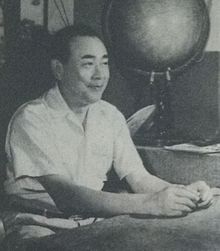Sadatoshi Tomioka (original) (raw)
From Wikipedia, the free encyclopedia
Japanese admiral (1897–1970)
| Sadatoshi Tomioka | |
|---|---|
| Born | 8 March 1897Tokyo, Japan |
| Died | 7 December 1970(1970-12-07) (aged 73) |
| Allegiance |  Empire of Japan Empire of Japan |
| Service / branch |  Imperial Japanese Navy Imperial Japanese Navy |
| Years of service | 1917–1945 |
| Rank |  Rear Admiral Rear Admiral |
| Commands | Matsu, Sugi, Ōyodo, Naval Operations Bureau |
| Battles / wars | World War II |
Baron Sadatoshi Tomioka (富岡 定俊, Tomioka Sadatoshi, 8 March 1897 – 7 December 1970) was an admiral in the Imperial Japanese Navy during World War II.
Tomioka was born in Hiroshima, but was raised in Nagano prefecture. His father, Admiral Tomioka Sadayasu had been ennobled by Emperor Meiji for services in the Russo-Japanese War. He was a graduate of the 45th class of the Imperial Japanese Naval Academy in 1917, ranking 21st out of 98 cadets. He served as midshipman on the cruisers Iwate and Aso and as an ensign, he was assigned to the battleship Asahi.
As a sub-lieutenant, he served on the battleship Suwo, and destroyer Hagi. After attending advanced navigational training, he became chief navigator on the destroyers Hokaze and Tachikaze, and the oiler Shiriya.
On 14 May 1927, he was given his first command: the destroyer Matsu. After graduation from Naval Staff College in 1927 and promotion to lieutenant commander, he was assigned as naval attaché to France, where he remainder until June 1932. During this period, he was also part of the Japanese delegation to the World Disarmament Conference in Geneva Switzerland. After his return to Japan, he was assigned as chief navigator to the Kinugasa. From May 1933 onwards, he held various staff posts. He was promoted to commander on 15 November 1934 and captain on 15 November 1938.
Assigned to Imperial Japanese Navy General Staff as an Operations Section chief in October 1940, Tomioka continued to serve in that capacity during the first two years of the Pacific War, during which time he unsuccessfully opposed the attack on Pearl Harbor[_citation needed_]. He also strongly opposed Admiral Isoroku Yamamoto's plans for the Midway operation, proposing that Japan occupy the much more strategically important Fiji and Samoa island groups instead. Tomioka also pushed for a focus on the occupation of Port Moresby in New Guinea, either as a staging ground for an invasion of Australia, or to draw out the American carrier fleet as far as possible from its home bases. He was overruled when Yamamoto threatened to resign.
In January 1943, Tomioka was given a combat command, as captain of the Ōyodo. From September 1943, Tomioka served as chief of staff to the Southeast Area Fleet and was promoted to rear admiral on 1 November 1943.
Tomioka returned to Naval General Staff as the department's Operations Bureau chief in December 1944, and held that position for the remainder of the war. He was one of the official representatives of the Imperial Japanese Navy General Staff at the Japanese surrender ceremony on the USS Missouri (BB-63).
Tomioka in 1951
In his later years, Tomioka assisted in editing a Japanese history of the Pacific War and, in 1951, he served on a 12-man commission to assist the Japanese government in the establishment of the present day Japan Self-Defense Forces. He later was lecturer at the Japanese Defense Research Institute, until his death in 1970.
- Dupuy, Trevor N. (1992). Encyclopedia of Military Biography. I B Tauris & Co Ltd. ISBN 978-1-85043-569-3.
- Fuller, Richard (1992). Shokan: Hirohito's Samurai. London: Arms and Armour Press. ISBN 978-1-85409-151-2.
- Nishida, Hiroshi. "Tomioka, Sadatoshi (Naval Academy 45th)". Imperial Japanese Navy. Archived from the original on 30 January 2013. Retrieved 14 August 2007.
- USSBS. "Campaigns of the Pacific War". Retrieved 14 August 2007.
